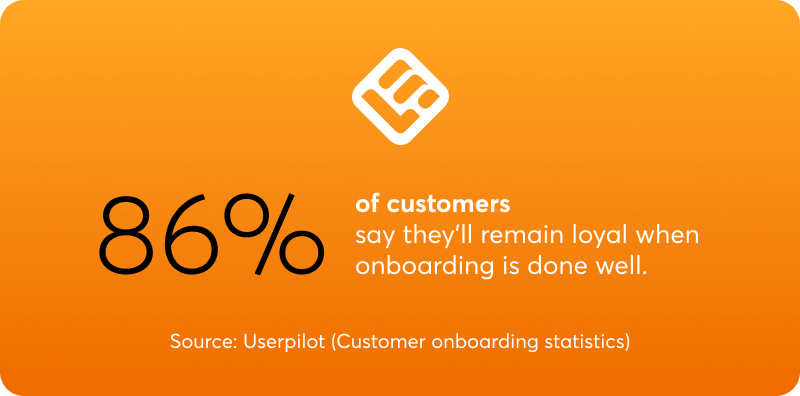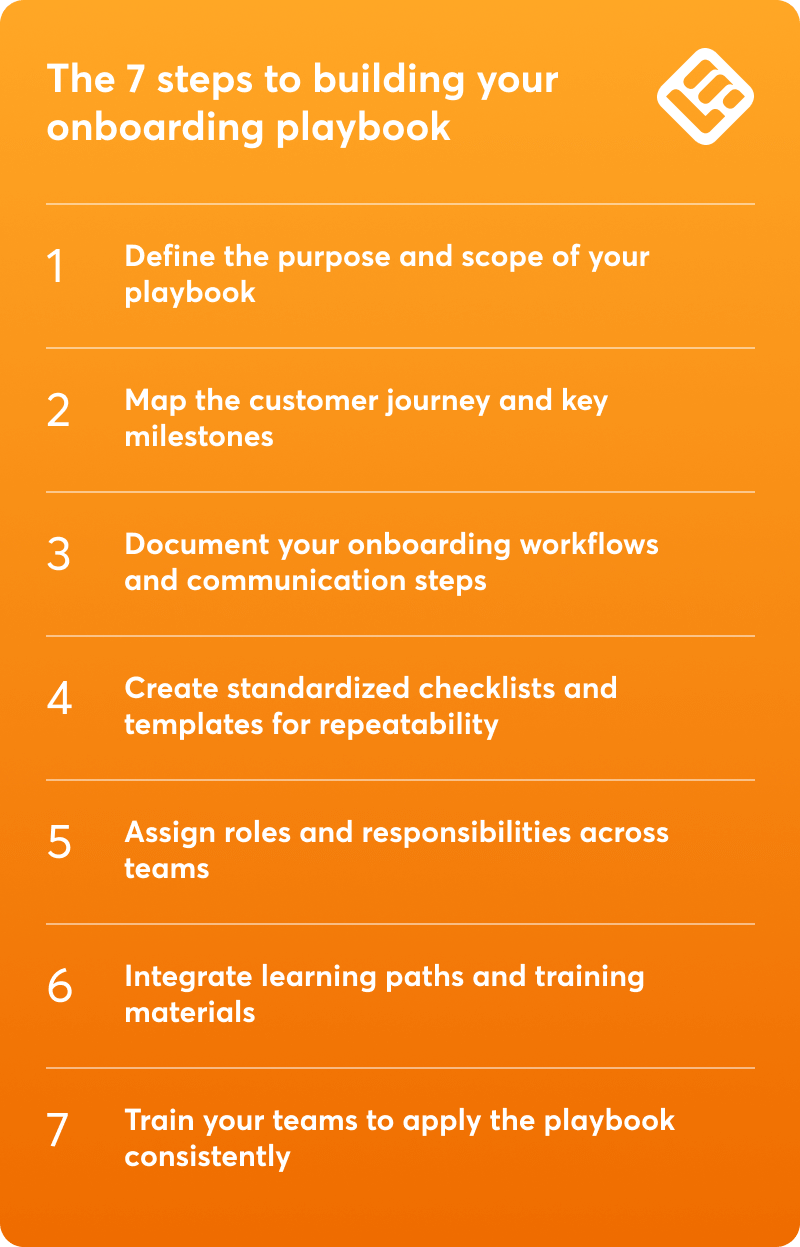Table of Contents
Remember that software or app you were sure was going to make your life x-times easier? It ticked all your boxes, but unfortunately, you just couldn’t figure out how to make it work. I can think of a few myself, and they’re sitting in the dusty corners of my phone, potential untapped, login information long forgotten.
It’s a frustrating, but common experience: 74% of potential customers will ditch a product if the onboarding process is complicated [1]. Fortunately, a clear onboarding framework can help you avoid that and improve customer retention.

In this guide, I’ll show you how to build that framework. You’ll learn practical steps and customer onboarding playbook examples you can adapt to your own product or service.
What is a customer onboarding playbook?
A customer onboarding playbook is a simple, structured guide that outlines how you help new customers get started. This gives your customers a clear path and starting point and removes the guesswork from their first experience with your product.
A good playbook also keeps your teams aligned. Instead of each person handling onboarding their own way, you have one shared process that’s easy to follow and repeat. It takes into account customer onboarding strategies to reduce confusion and help customers reach value faster.
Why a customer success onboarding playbook matters for SaaS teams
A customer success onboarding playbook matters for SaaS teams because it creates a consistent, repeatable way to guide new customers. Without one, customers may not get the support they need, and your overall customer satisfaction might decline.
And customer data shows a good framework has a real impact: 86% of customers say they’ll remain loyal when onboarding is done well.

A clear playbook also reduces the load on your team. Instead of answering the same questions or rebuilding the process for each customer, you have one shared path everyone can follow. When that path is supported by training materials inside a learning management system (LMS), it can improve your SaaS user adoption.
4 customer onboarding playbook examples
Onboarding doesn’t look the same for every company. Your approach will depend on factors like your product’s complexity, how many users you support, and the level of guidance your customers need.
These effective customer onboarding playbook examples highlight four common models you can adapt: self-serve, high-touch, hybrid, and education-led.

Self-serve customer onboarding playbook for product-led SaaS
If you run a product-led SaaS company, your goal is to help customers onboard themselves with as little friction as possible. A self-serve playbook gives users the steps they need to get started independently.
It usually includes:
A well-created self-serve onboarding helps your customers see value fast without adding more manual work to your team.
High-touch onboarding playbook for enterprise clients
Enterprise customers may expect a more guided experience. A high-touch playbook outlines every collaborative step, from kickoff to implementation to milestone reviews.
This model relies on clear roles: a CSM to manage the relationship, an implementation specialist for setup, and an account manager to support long-term success.
Use clear documentation and regular check-ins to keep the process predictable for you and your customer.
Hybrid customer success onboarding playbook for scaling teams
A hybrid onboarding model combines automated workflows with selective human touchpoints. For mid-market SaaS teams, this often means:
The goal with a hybrid onboarding playbook is to scale your onboarding without losing the personal touch that helps customers stay confident
Landon Murie, CEO at Goodjuju Marketing
Customer education playbook for long-term adoption
An education-led playbook gives your customers the ongoing training they need to fully understand your product. With it, they are more likely to move forward with confidence and use your product quickly.
This type of customer success playbook often includes:
Your customers use these resources to move from basic product setup to deeper, more advanced use cases at their own pace.
And don’t forget the digital aspects. When you connect onboarding to broader digital adoption, you support long-term engagement and not just early activation. This means customers gain needed skills to get more value from your product, and your team spends less time answering support tickets.
What to include in your customer onboarding playbook
No matter the type of playbook you end up with, there are some non-negotiable elements that it should include. When I researched how SaaS teams structure onboarding, the same key features showed up. I’ve distilled those core features into this list to help your planning.
Your customer onboarding playbook should include:
I also recommend strengthening your playbook with tools that support AI-powered onboarding. AI can help you personalize touchpoints, automate routine steps, and spot potential issues before your customers run into them. This makes your onboarding easier to scale as your customer base grows.
With these pieces in place, your playbook has what it needs to become a system your team can follow for every new customer. Now, let’s look at how you can establish a repeatable onboarding process.
How to build an onboarding playbook step by step
To build a strong playbook, you need a clear structure that guides your team and your customers through onboarding. The steps below will help you define that structure by outlining your goals, mapping the customer journey, and documenting the workflows that support it.

By the end, you’ll have a practical framework you can use every time you onboard a new customer.
Step 1: Define the purpose and scope of your playbook
You first need to know why you are building your own onboarding playbook. What goals do you want this playbook to help you reach? Think about the problems you want the playbook to solve.
Do you want to reduce ramp time? Increase adoption? Your goals will determine how detailed the playbook needs to be and what it should focus on. You also need to define the scope. Different customers need different levels of guidance. A small account may only need a quick-start path, while an enterprise customer may require a full implementation plan.
Set clear boundaries for where your playbook begins and ends. You might start at contract signing, first login, or the kickoff call. You might end at first value, full adoption, or handoff to long-term success.
For example, a SaaS team might scope their playbook to:
Step 2: Map the customer journey and key milestones
Once you know your scope, map the journey your customers need to follow accordingly. Break the experience into clear stages that reflect how customers actually move through your product.
Common stages for a customer success onboarding playbook might include:
Each stage should have one main action and one expected outcome. This keeps the journey focused and helps you spot gaps or moments where customers often stall. You want your journey map to highlight exactly where customers need guidance and what success looks like at every step.
For example, you might define “activation” as completing account setup and “first value” as creating a project or launching a workflow. These markers give you a measurable way to track customer progress.
Step 3: Document your onboarding workflows and communication steps
Now that you’ve mapped the journey, document the workflows that move customers through each stage. List the actions your team needs to take, the order they should happen in, and the owners responsible for each step. This turns unwritten habits and individual approaches into a clear onboarding process your entire team can follow.
You should also document every communication touchpoint. Include your emails, call agendas, in-app messages, and channel-specific scripts. Specify when each message goes out, why it matters, and who sends it.
You want to use clear, explicit communication to remove guesswork and keep the onboarding experience consistent.
Pro tip
Step 4: Create standardized checklists and templates for repeatability
Checklists and templates help make your workflows more actionable. When you create simple checklists for each stage of onboarding, you reduce the chances of skipping steps and make it much easier for every CSM to follow the same onboarding process.
Templates add the same level of consistency to your communications. You can standardize welcome emails, kickoff agendas, recap messages, and anything else you send repeatedly. This saves time and gives your customers a more predictable experience, no matter who they’re working with.
For example, you could build a “first-week checklist” to keep your onboarding organized and give every customer a clear start. Here’s what it could include:
First week onboarding checklist
One thing I love about modern LMSs, too, is that you can often automate these onboarding processes completely. So once you have the checklist created and the frameworks in place, they operate without your hands-on oversight.
Step 5: Assign roles and responsibilities across teams
Define clear ownership for every part of your onboarding process so tasks don’t get duplicated or overlooked. When each team knows exactly what they’re responsible for, customers move through onboarding more smoothly. Plus, your internal handoffs become much easier to manage.
Look at the journey you mapped earlier and assign responsibilities based on what each stage requires. This gives your customer success teams a predictable structure to follow and helps new members understand the process without relying on unwritten knowledge.
Here’s a simple example of what an assignment sheet could look like.
Customer Success Manager (CSM)
Implementation/Onboarding Specialist
Customer Support Team
Product / Documentation Team
Step 6: Integrate learning paths and training materials
Training is a core part of any onboarding program, and your playbook should show exactly how customers learn to use your product. Connect each stage of the journey to the training materials that support it.
This could include:
If you deliver this inside a platform like LearnWorlds, you can build self-paced courses, track engagement, and update materials without slowing down your customers’ progress.
Use the four customer onboarding playbook examples mentioned earlier to guide you.
For example, if you’re following a self-serve onboarding playbook, you might assign a short “Getting Started” learning path right after account setup. From there, a feature-specific module can guide customers toward their first value moment without them waiting for a live session.
💡Keep learning: How we built a smarter academy: Efficient methods to update training materials in SaaS.
Step 7: Train your teams to apply the playbook consistently
Even the strongest playbook only works when your customer success team knows how to use it. Set aside time to walk everyone through the onboarding process and show how the pieces fit together. This helps your team build confidence with the new workflow and reduces the chances of people slipping back into old habits.
And make training practical. Review real customer scenarios, run short practice sessions, and check for any gaps or misunderstandings. As your product evolves, revisit the playbook and update your internal training so everyone stays aligned.
Pro tip
Top strategies and plays for effective onboarding
There are a few strategies that make onboarding easier for both you and your customers. These give people a clear path to follow by reducing friction and help your team stay aligned as they guide customers through product adoption.
A successful customer onboarding playbook pulls these strategies together and uses them to move customers toward activation and long-term success.
Here they are at a glance and a table showing you how they can be applied:
Customer onboarding playbook strategies
Use these strategies as clear reference points in your onboarding playbook. They help your team guide customers across different segments and product areas. When your playbook reflects these practices, your customers can move forward with fewer obstacles, and your team can avoid preventable issues.
💡Keep reading: 6 successful customer training examples that will inspire you.
Turn your onboarding playbook into a scalable learning experience with LearnWorlds
LearnWorlds features help you turn your onboarding playbook into a structured learning experience. You can create self-paced courses and build guided learning paths using videos, tutorials, and interactive activities so customers learn exactly what they need at the right time.
You can also take ideas from your customer onboarding playbook examples and turn them into repeatable education. LearnWorlds lets you personalize training for different roles and update materials as your product evolves. This reduces repetitive work for your team and gives customers a smoother, more predictable path to value.
Ready to deliver onboarding that scales? Now is the perfect time to start. Try a free trial of LearnWorlds.
Sources
[1] State of the connected customer – Salesforce research

Ciera Lamb
Ciera is a freelance content writer and editor connecting companies with their ideal audiences through blog articles and other online content. She approaches her writing with curiosity and research and enjoys the ever-present learning that comes with being a content writer. She is also an avid scuba diver, an aspiring Dutch speaker, and lover of all things nature.
Kyriaki is the SEO Content Manager at LearnWorlds, where she writes and edits content about marketing and e-learning, helping course creators build, market, and sell successful online courses. With a degree in Career Guidance and a solid background in education management and career development, she combines strategic insight with a passion for lifelong learning. Outside of work, she enjoys expressing her creativity through music.
FAQ
Everything you have ever wondered, but were too afraid to ask...
Any team that wants consistency throughout the entire onboarding process needs a customer onboarding playbook. If your customers depend on setup, training, or guided steps to get value, a playbook helps you deliver the same experience every time.
You also need one if you want to streamline your product training for customers and cut down on repeated explanations during early adoption.




